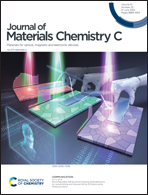A2Zn3P4S13 (A = Rb and Cs): First Infrared Nonlinear Optical Materials with Mixed Thiophosphate Functional Motifs PS4 and P2S6†
Abstract
Two new IR NLO compounds, namely Rb2Zn3P4S13 (1) and Cs2Zn3P4S13 (2), have been obtained by introducing d10 closed-shell cations in an alkali-metal containing thiophosphate system. Compounds 1 and 2 are isostructural and feature a 3D [Zn3P4S13] anionic framework. Both compounds exhibit moderate phase-matching SHG intensities at 1910 nm (0.1 × AGS for 1 and 2) and high LIDTs (6.1 × AGS for 1 and 5.2 × AGS for 2). They have wide transparent regions of 2.5–17.7 μm and 2.5–17.0 μm for 1 and 2, respectively, which cover the important far-IR atmospheric window of 3–5 and 8–14 μm for practical applications. Both compounds simultaneously contain two types of NLO-active thiophosphate units (PS4 and P2S6) in their structures, which to the best of our knowledge, is unprecedented in known IR NLO thiophosphates. The NLO efficiencies of 1 and 2 are mainly due to the covalent [Zn2P2S7]2− framework, in which the contribution of P2S6 units is remarkably larger than that of the PS4 units. This work sheds light on the design of promising IR NLO materials by mixing different thiophosphate functional motifs.



 Please wait while we load your content...
Please wait while we load your content...